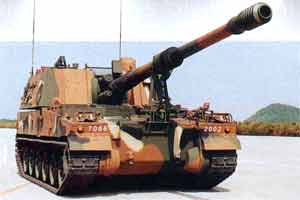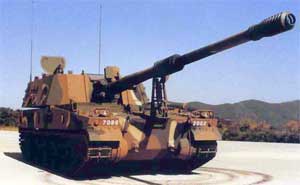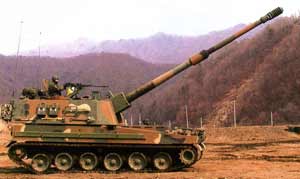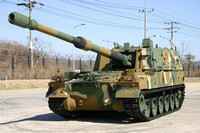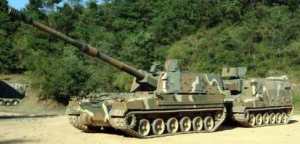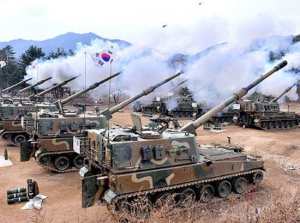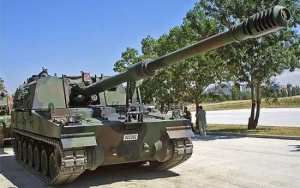| Designation: | K9 Thunder |
 |
|---|---|---|
| Manufacturer: | Hanwha Techwin CO. LTD. | |
| Product type: | Armoured Vehicles | |
| Name: | Self-propelled howitzer |
The new K9 howitzer, South Korean designed and developed, will give the Republic of Korea Army a significant improvement in capability over the current M109A2. With a claimed a range of 40 km, it offers greater mobility, longer range and higher rate of fire, and increased battlefield survivability as it can quickly be brought into action, open fire and come out of action. It is, therefore, less likely to be engaged by counterbattery fire. K9 is an indegenous system of an all-welded steel armour contruction which is rated to withstand impact by 14.5mm armour piercing shells and 152mm shell fragments. The main armament consists of a 155mm/52 caliber ordnance with a maximum firing range of 40km. State-of-the-art mobility subsystems include a 1,000 horsepower engine with potential for growth and hydropneumatic suspension unit.
Domestic development of the KH-179 and the armament which is constructed, and KM109A2 coproduction of ammunition, led to a new style self-propelled artillery. The development program of this 155mm/52-caliber self-propelled howitzer has been underway since 1989. In 1996 the first prototype of this new artillery system was tested. The contract for the new K9 artillery system was awarded to Samsung Aerospace Industries (SSA) by the Korean Government on 22 December 1998. The contract, the South Korean Army received the first production batch of K9 from prime contractor SSA in 1999, making it the second country to deploy such a system.
The K-9 considered international ammunition compatibility, and it adopted a basic plan of armament and ammunition in order for the development to be completed. For export to be possible, it uses the standards international common 155 mm caliber ammunition. The system includes the point weapon system, armament, ammunition, and the gun. It developed turret driving gear and the infrastructure from domestic sources, and considered economical efficiency in the navigation system, engine and transmission introduced from foreign countries. The suspension system was from in-country production, after introduction of technical know-how.
The K-9 overcame the numerical inferiority of North Korea preparation fire in the short-term. And in order for the defense of the fatherland to be possible from circumference environment of all Korea, the rate of fire and reactivity were maximized, along with survivability and a mobility. The maximum range is planned in order for the Corps fire support to be possible.
After receiving a fire command, the K9 thunder is able to fire on a target within 30 seconds at emplacement and within 60 seconds from movement. Even though TOT (time on target) firing may be accomplished by several howitzers simultaneously, the K9 thunder is able to more efficiently accomplish the same task by simply changing its fire data. The K9 thunder alone can produce three times as much as the M109A2 155mm SPH in firing capability.
The hull and turret of the K9 are of all-welded steel armour construction with a maximum thickness of 19 mm. This provides the occupants with protection from medium calibre small arms fire and 155 mm high-explosive shell fragments.
The K9 has a crew of five, driver and four in the crew compartment, with the latter consisting of commander, gunner, assistant gunner, and ammunition loader.
The driver being seated front left with the power pack to his right and with the remainder of the vehicle being taken up by the turret and crew compartment.
The driver enters his compartment by a rear opening roof hatch that can be locked in the horizontal position. The driver has three forward-facing day periscopes, the centre one of which can be replaced by a passive night vision device.
Wherever possible, to reduce development time and costs, proven subsystems were used in the development of the K9. The power pack for example consists of the German-designed MTU MT 881 Ka 500 V8 water-cooled diesel developing 1,000 hp, coupled to an Allison Transmission Division X1100-5A3 fully automatic transmission with four forward and two reverse gears. This transmission is a further development of that installed in the General Dynamics Land Systems M1 series of MBT.
The diesel fuel tank is located at the front right side of the hull with the battery compartment being front left. The air intake and outlet louvres are in the roof, with the exhaust outlet on the right side.
The indirect fire sight is mounted on the left side of the turret roof and is provided with a ballistic cover.
The commander and gunner are seated on the right side of the turret. Mounted on the forward part of the commander's cupola is a .50 (12.7 mm) M2 HB machine gun for air defence/local defence purposes and a single-piece hatch cover is provided which opens to the rear. A door is provided in the left side of the turret and there is also a large door in the chassis rear for crew entry and ammunition resupply purposes.
The 155 mm/52 calibre main armament has a chamber volume of 23 litres and is fitted with a slotted muzzle brake and fume extractor.
The large multiple slotted muzzle brake reduces the firing impulse applied to the recoil system and also provides a superior capability of attenuating the blast overpressure and flash. The vertically sliding breech mechanism automatically opens upward after firing and obturates the propellant gases with the high-strength obturator ring in the barrel assembly.
The primer magazine automatically feeds, inserts and extracts the primers and movement of the breech block allows for the continuous firing capability of 21 rounds.
The gun mount, which consists of two hydraulic recoil brakes with an internal buffer and a pneumatic recuperator, reduces the firing impulse to the chassis. The high-rigidity cradle is fitted to the autoloader to the rear, which has enhanced the firing accuracy by minimising the lateral motion of the barrel when firing.
When travelling the 155 m/52 calibre barrel is held in position with a travel lock installed on the forward part of the hull, this is operated by the driver by remote control, so ensuring the NBC integrity of the vehicle.
Mounted over the rear part of the 155 mm/52 calibre ordnance is a muzzle velocity measuring system that feeds information to the onboard computer. This Doppler-type system has a muzzle velocity recording range of from 20 to 2,000 m/s.
A burst rate of fire of three rounds can be fired in 15 seconds, with a maximum rate of fire of six to eight rounds a minute for a period of 3 minutes. Sustained rate of fire is two to three rounds a minute for 1 hour. A thermal warning device is fitted as standard and this feeds the temperature of the barrel to the Automatic Fire-Control System (AFCS).
Firing a standard M107 high-explosive (HE) projectile a maximum range of 18 km can be achieved. Maximum range firing an M549A1 HE Rocket Assisted Projectile (RAP) with uni-charge of five zones is 30 km. Firing the new locally developed K307 high-explosive base-bleed projectile with a six zone charge, a maximum range of 40 km can be achieved with a chamber pressure of 52,000 psi and a muzzle velocity of 924 m/s. It can also fire the locally developed K310 dual-purpose improved conventional munition base-bleed round to a maximum range of 36 km.
Using its onboard computerised fire-control system it can carry out Time On Target (TOT) procedures and put three rounds onto the target at once.
The bustle rack of the turret has been designed to load four types of 155 mm projectile and is fitted with four independently operated electrical drives which can be operated manually in an emergency. A total of 48 projectiles and their associated charges are carried for ready use.
Internally an automatic loading system takes projectiles from the storage position and places them onto the ammunition tray ready for ramming. The projectiles are loaded into the chamber automatically by the flick rammer. The charges are loaded manually. Although it can use a conventional bag type charge system (M3A1, M4A2, M119A1 and M203) the K9 has been optimised for use with a locally developed modular charge system.
The new modular charge system comprises two charges. One is a uni-charge, used for up to five zones (five increments) and another is a module-type charge for zone six only (two increments).
The new K307 projectile is a high-explosive extended-range full-bore base bleed (HE ER FB BB) type which features an aerodynamic body and base bleed to achieve its enhanced range.
Standard equipment includes a Honeywell Modular Azimuth Position System, Automatic Fire-Control System, powered gun elevation/depression and turret traverse system. The K9 Thunder can open fire within 30 seconds if it is already stationary or within 60 seconds if it is moving.
Information to lay the weapon onto the target can be transmitted from the battery command post to the K9 Thunder via a data digital radio link or voice communications and the system can also calculate laying data using its onboard fire-control equipment. The computerised fire control system for the K9 Thunder self-propelled artillery system has been developed by Samsung Thales specifically for this artillery system. This includes a display unit, system control unit, fire control unit, communication processor which are all linked via a 1553 data bus to the power control unit. According to Samsung Thales, key features of this computerised fire control system include automatic/manual data input, common module conception, real time ballistic solution, simple man/machine interface, easy to modify program through RS422 port, built in test and a high precision ballistic solution.
Suspension system is of the hydropneumatic type, with each side having six dual rubberised road wheels and with the drive sprocket at the front, idler at the rear and three track-return rollers. Track is of the double-pin type with replaceable rubber pads.
Subcontractor for the suspension is Tong Myung Heavy Industries who signed a contract with Air Log of the UK in 1995 for the supply of an undisclosed quantity of 'Hydrogas' suspension units and licence production of these in South Korea. This is similar to that used on the now BAE Systems Land Systems (previously RO Defence) 155 mm AS90 self-propelled artillery in service with the Royal Artillery. Air Log is no longer in existence and production is now undertaken by Horstman Defence Limited.
The K9 Thunder is also fitted with an NBC system, heater, internal and external communications system and a manual fire suppression system.
The company is already studying a number of enhancements for the K9 Thunder for other export customers in Asia and elsewhere, such as the installation of an air conditioning system.
Additionally, December 16 2014 was awarded the contract for the supply of 120 chassis K9 Thunder self-propelled guns to Poland company Huta Stalowa Wola (HSW). The contract value is $ 320 million. The chassis will used for build 155mm/52-cal SPH Krab for the Polish Army on their base. The first 24 chassis will be delivered in 2015-2017, the remaining 96 in the 2018-2022.
|
||||||||||||||||||||||||||||||||||||
|
||||||||||||||||||||||||||||||
|
||||||||||||||||||
|
|||||||||||||||||||||||||||||||||||||||||||||||||||||||







